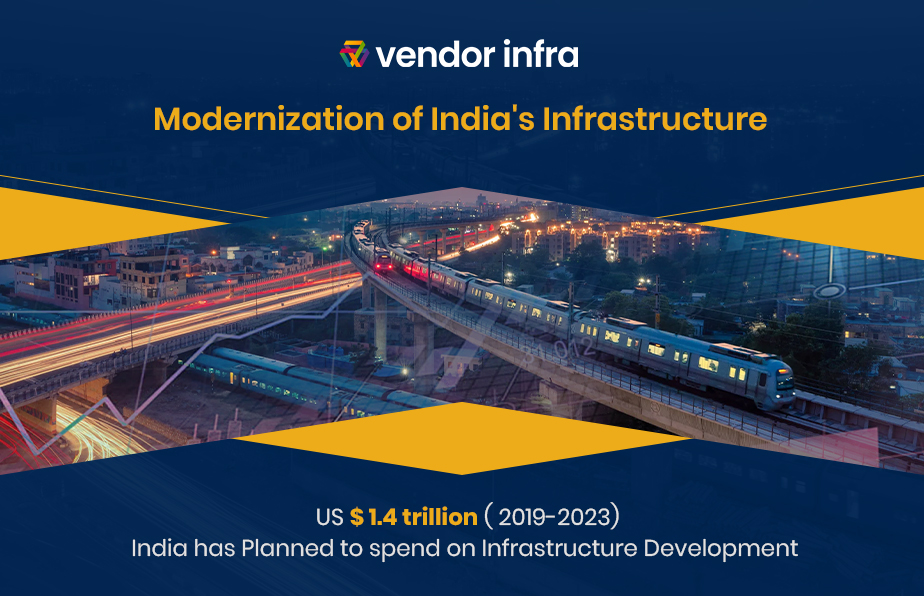The infrastructure sector is the foundation of the nation. One of the most resilient sectors plays a critical role in fast-tracking a country’s overall development, promoting economic growth. India’s competitiveness across the globe has mainly benefitted from the increased spending by the Indian Government. As per the report by India Brand Equity Foundation, India has planned to spend US$1.4 trillion on infrastructure development from 2019-2023, which was predicted to boost the growth of the sector, and one can ascertain with the current new metro projects(Kochi, Nagpur, Nashik, Chennai) that, it’s right on track.
In the last decade, the infrastructure sector of India has grown tremendously, making the lives of citizens easier by job creation and boosting the local economy. With the investments promised under the Union budget in 2021, around US$ 138 billion to be used for various projects, ranging from financing solutions to pipelines for fuelling infra growth. The improvement in Infrastructure development further provides drive to investments in India.
Government Schemes
The Indian infrastructure sector has a trickle-down effect on several other industries. India will become the world’s 3rd largest construction market by 2022. To strengthen the industry further, the Government has announced several initiatives to remarkably impact the country’s infrastructure. Looking at the current Indian scenario, the Government has announced plans to allocate Rs. 233,083 crore to give a boost to transport and augment transport infrastructure. The National Bank for Financing Infrastructure and Development (NaBFID), which was set up in March 2021, also proves to benefit the seamless funding of infrastructure projects in India. As a result, many infra projects will have a productive conclusion. The Government envisioned Mega Investment Textiles Parks (MITRA) scheme to establish seven new textile parks in the coming three years and develop world-class Infrastructure for the Indian textile sector.
Boosting railway infrastructure
Indian railways are always top of the line when it comes to reinventing themselves, whether designing their coaches or adopting new technologies for their coaches. The current boost is to support freight movements. The ministry has announced to set up dedicated freight corridors in eastern and western India to facilitate cargo operation. The Western Dedicated Freight Corridor (WDFC) will involve the construction of a 1483km freight line to connect Dadri, Delhi, and Navi Mumbai. Eastern Dedicated Freight Corridor (EDFC) will include constructing a 1839km-long freight line connecting Punjab to West Bengal. The modernization of railway stations would also be undertaken as per the Adarsh station scheme. This would include improvement of facades, platform surfaces, waiting area and waiting rooms, foot overbridges, and escalators.
Roadways network Expansion
Apart from strengthening the railway network, the country is focusing on expanding its road network by allocating its resources to construct new roads. The Government has commenced Bharatmala Pariyojana – a new program for the highways sector, To optimize freight and passenger movements. Bharatmala Pariyojana bridges serious infrastructure gaps involving the construction of Economic Corridors, Inter Corridors, and Feeder Routes, National Corridor Efficiency Improvement, Border and International connectivity roads, Coastal and Port connectivity roads, and Green-field expressways. Additionally, there will be an increased emphasis on technology and scientific planning for asset monitoring and management.
Furthermore, building new highways and expanding existing ones is a primary unconventional mode of ensuring seamless roadways infrastructure. The NHAI has recently set the timeline for 23 new highways to make them ready by 2023. This can only be implemented by a smooth cash flow in the sector which is planned to be solved by the setting up of SPV (Special Purpose Vehicle) for the Delhi-Mumbai expressway.
Conclusion
The growth trajectory of the space denotes the sustainable development of the country. If all the proposed plans and policies work as they are envisioned with the same ardor, the sector would be becoming one of the most promising sectors of the Indian economy and would help in putting India on a global level.



Interesting topic and engaging content. Well written article.